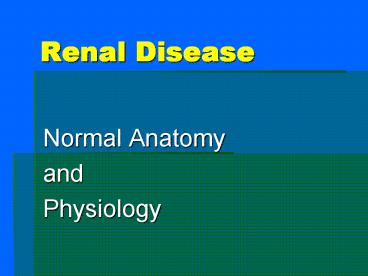Renal Disease - PowerPoint PPT Presentation
Title:
Renal Disease
Description:
fistula arm. 2. Assess for anemia. 3. Increased risk of bleeding (heparin ... bleeding / petechiae. osteodystrophy. 7. ??? Prophy Abs for fistula ??? Questions? ... – PowerPoint PPT presentation
Number of Views:43
Avg rating:3.0/5.0
Title: Renal Disease
1
Renal Disease
- Normal Anatomy
- and
- Physiology
2
Renal Normal Anatomy 1. Renal artery and
vein 25 of blood volume passes through the
kidney / minute 2. Cortex / Papillae / Pelvis /
Ureter / Bladder / Urethra
3
Kidney Cortex Papilla Pelvis Ureter
4
Renal Normal Anatomy 3. Nephron high
pressure glomerular filtration of H2O ions, drugs
and wastes (urea) 4. Tubular reabsorption of
ions / H2O, concentration of urine
5
Renal Normal Anatomy 5. Juxtaglomerular
apparatus renin / angiotensin system
6
JGA
Nephron PCT DCT Glomerulus Renal artery Renal
vein Loop of Henle Collecting duct
7
Renal Normal physiology 1. Control of fluid
volume H20 2. Control of electrolytes Na /
K 3. Control of blood pressure renin /
angiotensin / aldosterone
8
- Renal Normal physiology
- Renin / Angiotensin / Aldosterone
- Renin secreted by JGA in response to BP or
- chronic Na depletion
- Renin catalyses the production of angiotensin I
(a - decapeptide) from a circulating protein
- 3. Angiotensin converting enzyme (ACE) in the
lungs - cleaves off 2 more amino acids to form
- Angiotensin II (an octapeptide)
9
- Renal Normal physiology
- Renin / Angiotensin / Aldosterone
- Angiotensin II
- is a potent vasoconstrictor and
- it stimulates the release of aldosterone by the
- adrenal cortex
- Aldosterone acts on the collecting tubule to
increase - the reabsorption of Na (and, therefore H2O)
10
Renal Normal physiology 4. Control of acid /
base balance pH 5. Filtration of the
blood elimination of metabolic wastes 6. Drug
metabolism
11
- Renal Normal physiology
- Control of Ca / PO4
- activation of vitamin D
- 8. Red blood cell regulation
- erythropoietin
12
Renal failure Definition ESRD (end stage renal
disease) Loss of 50 to 75 of nephrons This
implies a huge amount of reserve within the
system Will have 2 in 2000 patient practice
13
- Renal failure Causes
- Diabetes mellitus (34)
- micro and macrovascular disease
- 2. Hypertension (25)
- 3. Chronic glomerulonephritis (16)
- 4. Others (polycystic kidney disease,
- SLE, neoplasms, AIDs, etc)
14
- Renal failure Assessment
- Urinalysis protein or blood
- 2. Creatinine increased
- 3. BUN increased
- 4. K increased / Na decreased
15
Renal failure Assessment 5. CBC anemia /
thrombocytopenia 6. INR / PTT
increased 7. Creatinine clearance
decreased 8. GFR decreased
16
Renal failure Assessment GFR (glomerular
filtration rate) (based on serum
creatinine) Normal 100-150 ml/min
17
Renal failure Assessment GFR Normal
100-150 ml/min Renal Insufficiency
50-90 Moderate renal failure 10-50 Severe
renal failure lt 10
18
- Renal failure Stages
- Diminished renal reserve
- mild increase in Creatinine and
- 10 to 20 decline in GFR
- Renal Insufficiency increase in
- blood urea nitrogen (BUN) and
- 20 to 50 decline in GFR
19
- Renal failure Stages
- Renal failure Uremia
- (gt 50 decline in GFR)
- with loss of
- excretory
- endocrine and
- metabolic function
20
- Renal failure Pathophysiology
- Irreversible loss of nephrons
- Kidneys are able to compensate
- until 50 to 75 of nephrons
- are lost
- 3. Initial polyuria followed by uremia
21
- Renal failure Pathophysiology
- Uremia is characterized by
- a. Fluid overload hypertension
- b. Congestive heart failure
- c. Pulmonary edema
- d. Urea buildup (azotemia BUN)
- e. Metabolic acidosis ( pH)
- f. Hyponatremia / hyperkalemia
22
- Renal failure Pathophysiology
- Uremia is characterized by
- g. Anemia
- h. WBC dysfunction immunity
- i. Platelet factor coagulopathy
- j. Renal osteodystrophy vit D
- secondary hyperparathyroidism
23
- Renal failure Management
- Conservative care fluid, K, Na
- protein and phosphate
- 2. Recombinant human erythropoietin
- 3. Treat (optimize) concommitant
- disease diabetes, hypertension
- CHF, infection, etc
24
Renal failure Management 4. Avoid nephrotoxic
drugs 5. Peritoneal dialysis (10) hypertonic
solution indwelling catheter frequent
exchanges
25
Renal failure Management 6. Hemodialysis
(90) every 2 to 3 days 3 to 4 hours /
session surgical fistula heparin (6 hour ½
life) risk of Hep B / C and HIV 1 year
survival 78 5 year survival 28
26
Renal failure Management 7. Kidney
transplant immunosuppression gingival
hyperplasia (cyclosporin and CCBs) chronic
steroid use 1 year survival 87 5 year
survival 76
27
- Renal failure Dental concerns
- Monitor blood pressure avoid
- fistula arm
- 2. Assess for anemia
- 3. Increased risk of bleeding (heparin
- effect and thrombocytopenia)
- 4. Increased risk of infection
28
Renal failure Dental concerns 5. Drugs avoid
NSAIDs and acetaminophen in high
doses reduce dose of tetracycline,
metronidazole acyclovir penicillins
cephalosporins
29
Renal failure Dental concerns 6. Oral
complications xerostomia candidiasis gingival
bleeding / petechiae osteodystrophy 7. ???
Prophy Abs for fistula ???
30
Questions????



























![Renal Denervation Market Size & Share Statistics [2030] PowerPoint PPT Presentation](https://s3.amazonaws.com/images.powershow.com/9748002.th0.jpg?_=20220418118)



